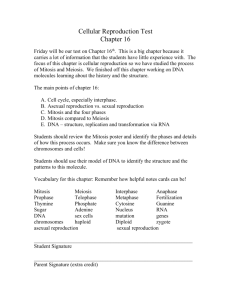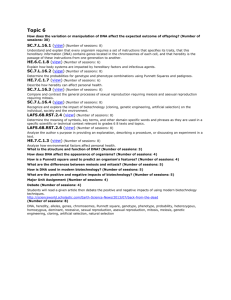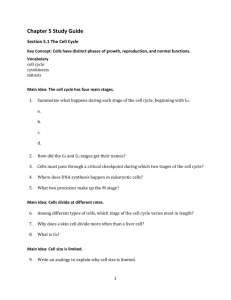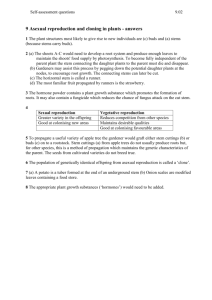Ch5-6 PPT - Asexual vs Sexual Reproduction
advertisement
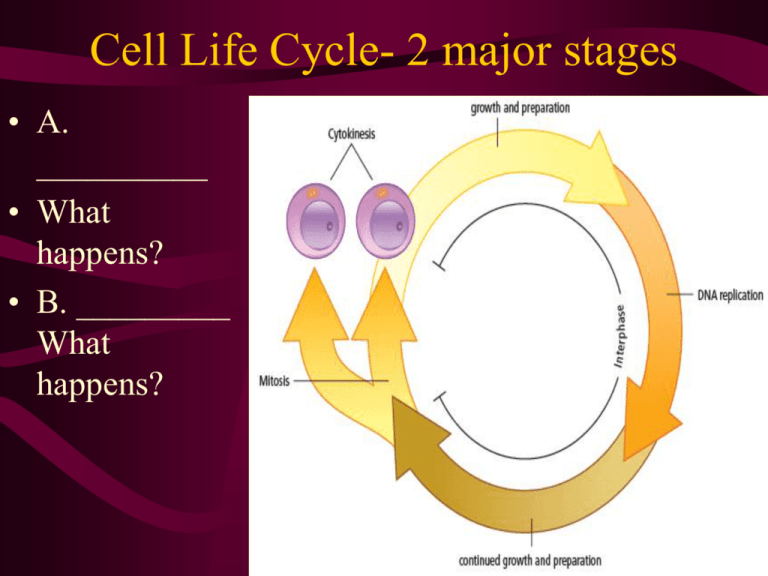
Cell Life Cycle- 2 major stages • A. __________ • What happens? • B. _________ What happens? Interphase – Between Mitotic phases • How long (relatively speaking) is this stage? • What does the DNA look like at this stage? • What happens at the very end of interphase? Mitosis • An highly organized method of replication creating identical daughter cells from one parent cell • When a cell loses control of mitosis, a CANCER may occur 4 Stages of Mitosis • • • • Prophase Metaphase Anaphase Telophase Mitosis Animated Prophase Chromatid • EVENTS: • Nuclear membrane breaks down • Chromatin coils into chromosomes • Centrioles move apart • Spindle fibres stretch across the cell • Chromosomes eventually attach to spindle fibres ONION ROOT TIP Metaphase • Spindle fibres pull the chromsomes to line up along the equator of the cell • Chromatids move to opposite poles of the cell Anaphase Telophase • The reverse of prophase • cell membrane starts to pinch • nuclear membrane forms around each set of chromosomes • Each has its own nucleus (and the cell is ready to divide) • Chromosomes at each end of the pole • Spindles fibres disappear Cytokinesis • In late telophase, the rest of the organelles … great animation of mitosis Checkpoints in the cell cycle will prevent division if: – If the cell is short of nutrients – If the DNA within the nucleus has not been replicated – If the DNA is damaged Mutations in genes involving checkpoints can result in an uncontrolled cell cycle. The result of uncontrolled cell division can = cancer. • Cancer cells have large, abnormal nuclei • Cancer cells are not specialized, so they serve no function • Cancer cells attract blood vessels and grow into tumours. • Cells from tumours can break away to other areas of the body Compare and Contrast Asexual and Sexual Reproduction -including the outcomes of mitosis and meiosis -including methods of asexual and sexual reproduction Asexual Reproduction • Produces genetically identical offspring • Requires only one parent • Is fast and efficient • Does NOT increase the genetic variation in the species Sexual Reproduction • Produces genetically unique offspring (new combinations) • Requires 2 parents • Increases the genetic variation of the species Methods of Asexual Reproduction • Binary fission Regeneration Fragmentation Vegetative Reproduction Grafting • Insert a scion (twig) of desired plant onto a stock of another • Scion will continue to grow as the desired plant Spore Formation • Bacteria • Microorganisms • Fungi Budding • Offspring grows attached to parent • Falls off when mature Human Assisted Cloning: • More complex plants and animals have lost the ability to clone themselves because their cells have become too specialized. • However, scientists have discovered how to assist the creation of clones in complex organisms. Human Assisted Cloning – how it’s done: Scientists can clone complex organisims for two reasons: 1. Reproductive Cloning: To produce a genetically identical organism that because it has desirable characteristics. 2. Therapeutic cloning: To create STEM cells (embryonic) for use in cell therapy. The stem cells can correct health problems, because stem cells can develop into any one of our 200 types of body cells! • Embryonic Stem cells can develop into ANY kind of cell in our body. • Therapeutic cloning - to correct health problems – Uses stem cells which can be used to replace cells damaged from injuries or disease What can we use use stem cells for? – Diabetes, spinal injuries, Parkinson’s disease are only a few that can benefit from stem cell therapy Animation of developent from egg to fetus (includes stem cells) Why is the use of stem cells considered controversial? Where else can you get stem cells? • Some blood stem cells can be recovered from the umbilical cord from newborn children http://www.blood.ca/CentreApps/Internet/UW_V502 _MainEngine.nsf/page/you_can_be_the_one_match_t o_save_a_life? A new way to get stem cells! (this example is combining gene therapy with stem cells!) The future?? Meiosis • A highly organized method of producing gametes (haploid) Cross-overs – mixing up the gene pool Outcomes of Mitosis and Meiosis • Mitosis Outcomes: 2 identical diploid cells • Meiosis outcomes: 4 unique haploid gametes Sexual Reproduction • Fertilization • zygote • Embryo - Fetus (around 8 weeks when major organs have developed) Factors that may Lead to Mutations. • A mutation is defined as a change in the DNA nucleotide sequence. • Changing the nucleotide sequence may change the sequence of amino acids • Changing the a.a.’s may change the protein (which is supposed to control a specific chemical reaction) Chemical Factors • Chemicals (ex. PCB’s) can change the genetic code by reacting with the DNA molecule, changing the chemical make-up of the molecule. Biological Factors • Viruses can change the sequence of nucleotides by inserting it’s genes into a sequence Physical Factors • Radiation is caused by high energy particles • These particles can literally crash into the DNA molecule, and cause pieces of the molecule to fall out. The cell will try to repair the damage – sometimes GUESSING what the piece that was missing coded for! • Other times, the cells simply splices the molecule back together, and hopes it will work out alright Positive Mutations • Sometimes, a change in the DNA sequence actually improves the function of an enzyme • Ex. There are some people that are immune to the HIV virus• that immunity was caused by some type of mutation Neutral Mutations • Sometimes, a change in the DNA sequence has no effect – either the amino acid stays the same as it was, or perhaps that part of the enzyme was not critical for it’s function Negative Mutations • Sometimes, a change in the DNA sequence will have a negative effect • Either the enzyme won’t get made at all, or it doesn’t work properly, or it has a negative effect on the animal • Eg. Hemophilia is caused by a mutation on the X chromosome Review: Structure of DNA • A long chain of nucleotides DNA uncoiled • The sequence of the nucleotides determines the sequence of Amino acids linked together by the ribosomes The code • A long chain of amino acids makes a protein. • The sequence of the amino acids determines the type of protein made Protein folding • DNA is a long chain of nucleotides • Ribosomes “read” the nucleotide chain and construct chains of amino acids based on the nucleotide sequence. • Chains of amino acids are PROTEINS So why do our GENES code for PROTEINS? • Is that all we are? PROTEINS? Proteins are ENZYMES • Enzymes control ALL the chemical reactions in the body. • If you know when to make the right enzymes, and how many to make, you can reconstruct yourself – from scratch • All your “GENES” are is instructions on how to make specific enzymes. • Mom gave you your “start-up” package with the first enzymes in it. • Those enzymes started making more enzymes, and you started developing.
